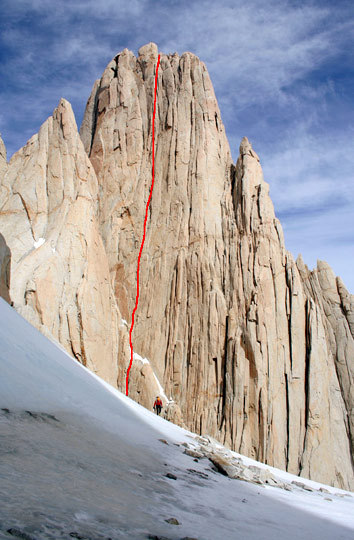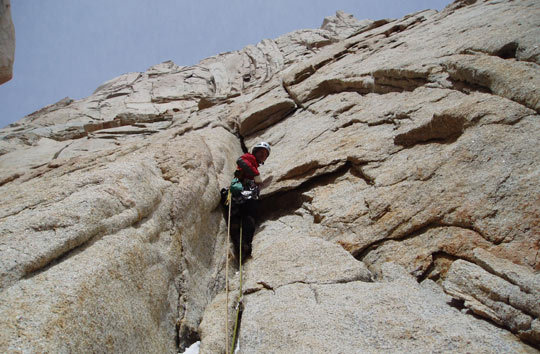
Banana Wall (VI 5.11a M6+ C1, 700m), a new sustained direttissima on the north face of Poincenot, Chilean Patagonia. Quebecois Sacha Friedlin envisioned the line while peering through the American Alpine Journal, then climbed it with countryman Frederic Maltais from January 17-19, 2008. The pair placed no bolts or pitons. [Photo] Anke Casten
The idea of opening a new route up the center of Poincenot’s (3002m) north face was envisioned by my partner, Sacha Friedlin, who studied Patagonian reports in the American Alpine Journal during long, boring nights working on James Bay, in the North of Quebec, Canada. This magnificent face in Argentine Patagonia–as far as he could tell–had no existing route up its center between the Crouch-Donini (5.10+ A1-2, 800m, 1996) and the Potter-Davis (5.11 C1, 550m, 2001). After getting some beta from Rolando Garibotti and Carsten Anke about the approach and feasibility, we headed in to that imaginary line.
We started at 3 p.m. from the Polack camp on January 17. Because the weather was turning bad, we were forced to stop at around 11 p.m. and spend three hours chopping an ice ledge three pitches above the col between Aguja Kakito and Poincenot. The next day, after unsuccessfully trying to sleep through heavy spindrift, we climbed slowly up icy cracks to reach a good bivy site at the end of Pitch 6, having fixed 120 meters of rope on the upper section. Perfect weather on the 19th allowed us to finish off the wall in a 24-hour push to the summit, then descend via the Whillans-Cochrane route on the other side.
We placed no bolts or pitons, so the route (VI 5.11a M6+ C1, 700m) is free of gear, even on belays. It is very sustained, as nearly every pitch is in the 5.10 range, with a few cruxes of 5.11a. We French freed in a few spots due to icy cracks–these sections easily would go free in warmer weather–and we encountered mixed climbing on the first three pitches, and on Pitch 6. The M6+ mixed crux (Pitch 3) involved unconsolidated vertical snow under overhanging rock passages but could be avoided by climbing a more practical line from Pitch 2 to the second bivy above Pitch 6.
We named the route Banana Wall in honor of the curving geometry of its high-quality granite cracks that graced almost every pitch. How different from Sacha’s boring nights on James Bay!

Friedlin working up the banana-like “high-quality granite cracks that graced almost every pitch.” [Photo] Frederic Maltais